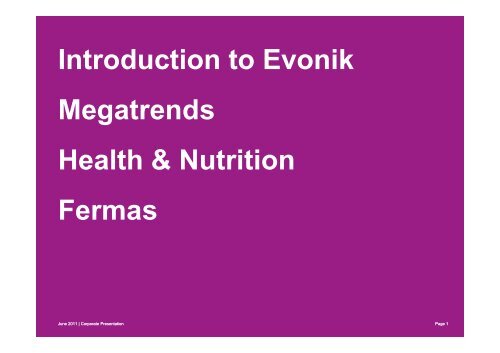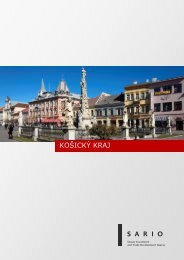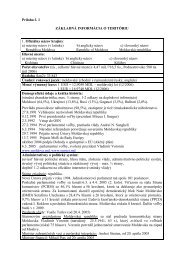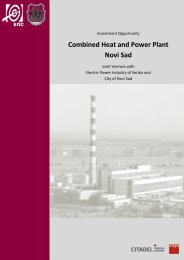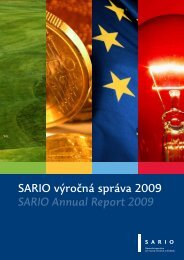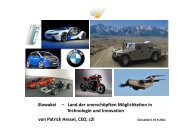Evonik Fermas.pdf - Sario
Evonik Fermas.pdf - Sario
Evonik Fermas.pdf - Sario
You also want an ePaper? Increase the reach of your titles
YUMPU automatically turns print PDFs into web optimized ePapers that Google loves.
Introduction to <strong>Evonik</strong><br />
Megatrends<br />
Health & Nutrition<br />
<strong>Fermas</strong><br />
June 2011 | Corporate Presentation Page 1
<strong>Evonik</strong> – an attractive company<br />
One of the global<br />
leaders in specialty<br />
chemicals<br />
Investments in the<br />
energy and real estate<br />
sectors<br />
Ownership structure:<br />
RAG-Stiftung<br />
(74.99%) and CVC<br />
Capital Partners<br />
(25.01%)<br />
2011 | Health & Nutrition Page 2
A worldwide presence<br />
2011 | Health & Nutrition Page 3
Key figures 2010<br />
Sales<br />
by Chemicals<br />
Real Estate<br />
EBITDA<br />
€13.3 billion<br />
€12.9 billion<br />
€0.4 billion<br />
€2.4 billion<br />
Profitability (EBITDA margin) 17.8%<br />
Return on capital employed (ROCE) 15.0%<br />
Employees 31.12.2010 34,407<br />
June 2011 | Health & Nutrition Page 4
Moving forward:<br />
Geared to megatrends<br />
Megatrend = a great, far-reaching, and sustained trend.<br />
Megatrends:<br />
• are long-term<br />
• are all-encompassing<br />
• send out signals in all areas of life<br />
• are generally global in scope<br />
Significant global megatrends:<br />
• Resource efficiency<br />
• Health and nutrition<br />
• Globalization<br />
June 2011 | Health & Nutrition Page 5
In 2050 over 9 billion people will need<br />
healthy food with scarcer land and water<br />
•Population<br />
• 35 % increase in population<br />
• 70 % of population becomes urban<br />
6.7<br />
bn<br />
2009<br />
9.0<br />
bn<br />
2050<br />
49%<br />
urban<br />
2009<br />
70%<br />
urban<br />
2050<br />
•Standard of living (affluence)<br />
• 10 % increase in food energy intake<br />
• 30 % increase in meat intake<br />
•Technology<br />
• 17 % decrease in land per capita<br />
• 70 % increase in water required<br />
for agriculture<br />
2850<br />
kcal<br />
2009<br />
0.23<br />
ha<br />
2009<br />
3130<br />
kcal<br />
2050<br />
0.19<br />
ha<br />
2050<br />
40<br />
kg<br />
2009<br />
2009<br />
52<br />
kg<br />
2050<br />
12200<br />
km 3<br />
7200<br />
km 3 2050<br />
Source: FAO 2009, OECD 2009, Bruinsma 2009, own calculations<br />
June 2011 2011 | Health | Health Corporate & Nutrition & Nutrition Presentation Page Seite 6 6
BU Health & Nutrition: structure<br />
aligned with the markets<br />
Nutrition and Health Care : huge challenges for mankind in the years to come<br />
growing global nutrition and health markets<br />
need of research, development and new ideas<br />
growth opportunities for <strong>Evonik</strong><br />
BU Health & Nutrition of <strong>Evonik</strong><br />
Health<br />
Preferred partner for pharma<br />
Nutrition<br />
Global leader in feed amino acids<br />
Health Care<br />
Bioproducts<br />
Methionine<br />
Drug delivery<br />
Systems<br />
API Custom<br />
Manufacturing<br />
Pharma<br />
Amino<br />
Acids<br />
Amino acids from<br />
biotechnological<br />
processes<br />
Amino acids from<br />
large scale chemical<br />
processes<br />
Market<br />
position<br />
No. 2<br />
Market<br />
position<br />
No. 2<br />
Market<br />
position<br />
No. 3<br />
Market<br />
position<br />
No. 2 / No. 5<br />
Market<br />
position<br />
No. 1<br />
June 2011 | Health & Nutrition Page 7
We reduce ecological footprints in<br />
animal protein production<br />
The challenge<br />
• 40 kg of meat is consumed per capita each year by<br />
the world population on average.<br />
• This has consequences: Animal protein production is<br />
a major emitter of green house gases.<br />
• For example: for 1 kg of pork 3.2 kg CO 2 -equivalents<br />
are emitted.<br />
• Other side effects are:<br />
• regional eutrophication<br />
• acidification of soil<br />
The Ecological Footprint is the area on<br />
Earth, which is necessary to maintain the<br />
lifestyle and standard of living of a person<br />
(under continuation of current production<br />
conditions).<br />
This includes the areas which are necessary<br />
for the production of his clothing, food and<br />
energy demand, but also the areas needed<br />
to decompose his waste and to bind the<br />
carbon dioxide released by his activities<br />
2011 | Health & Nutrition Page 8
We reduce ecological footprints in<br />
animal protein production<br />
Our contribution<br />
<strong>Evonik</strong> amino acids balance the amino acid mix in the<br />
feed: less soya and rape seed is needed<br />
This leads to a reduction of animal feed, land use,<br />
manure and nitrogen pollution of ground water.<br />
Life-cycle-analysis revealed: if DL-methionine is used<br />
instead of soya and rape seed …<br />
• Production emissions are compensated in the life cycle:<br />
• for 1 t ammonia 26 t are saved.<br />
• for 1 t CO 2 -equivalents 23 t are saved.<br />
• for 1 t nitrate<br />
7 t are saved.<br />
• energy consumption is redued by 80 %.<br />
This study was verified by the<br />
independent TÜV Rheinland.<br />
2011 | Health & Nutrition Page 9
Biotechnology is key to <strong>Evonik</strong> and the<br />
Health & Nutrition Business Unit<br />
<strong>Evonik</strong> has existing business based on biotechnology<br />
• Total turnover is approximately 400 m€ across <strong>Evonik</strong>. We don’t<br />
talk biotechnology, we do it!<br />
Biotechnology is a cornerstone of the <strong>Evonik</strong> growth strategy<br />
• Biotechnology supports new or improved products and<br />
improved manufacturing processes for growth of the health and<br />
nutrition business<br />
• Biotechnology makes renewable resources accessible for the<br />
production of industrial chemicals and additives, polymers and<br />
consumer products<br />
Expanding health and nutrition product portfolio<br />
• Biotechnology will help the Health & Nutrition business unit to<br />
develop new products. Biotechnology propels our growth.<br />
2011 | Health & Nutrition Page 10
<strong>Evonik</strong> <strong>Fermas</strong><br />
part of BU Health & Nutrition<br />
<strong>Evonik</strong> <strong>Fermas</strong> site at foot of Lower Tatry Mountains<br />
2011 | Health & Nutrition Page 11
<strong>Evonik</strong> <strong>Fermas</strong> key data<br />
Commercial production of feed<br />
amino acids via fermentation<br />
processes since 1993<br />
• Turnover: 43 Mio €<br />
• Employees: 180<br />
• Investment: 136 Mio €<br />
Specialized on biotechnological production/process development<br />
and tends to serve as scale-up and launch platform of biotechnological<br />
processes for entire <strong>Evonik</strong><br />
2011 | Health & Nutrition Page 12
<strong>Evonik</strong> <strong>Fermas</strong> headlines<br />
• Highly motivated and skilled people<br />
operate lab equipment fermentation and<br />
isolation facilitiesfor process development,<br />
production and scale-up tasks<br />
• respecting<br />
ISO standards 9001, 14001 and<br />
feed safety FAMI-QS<br />
• Backbone a set of 50m3 fermentors<br />
Which provide opportunities for high added<br />
value products and services<br />
2011 | Health & Nutrition Page 13
<strong>Evonik</strong> <strong>Fermas</strong><br />
challenges to meet future<br />
• Universality increase of downstream<br />
• Portfolio Increase to special products<br />
• Fermenters upgrade for special products<br />
• Laboratories equipped for a broader portfolio<br />
• Automation level increase in fermentation<br />
• Diversification of c-source infrastructure<br />
• More intensive personal exchange within <strong>Evonik</strong><br />
• More intensive cooperation with universities<br />
• Conversion / upgrade of waste to products<br />
2011 | Health & Nutrition Page 14
<strong>Evonik</strong> <strong>Fermas</strong><br />
Challenges to meet future<br />
• el. energy costs: SK No.4 in Europe<br />
• sugar price increasing<br />
• complicated possibility to get the European structural founds<br />
2011 | Health & Nutrition Page 15


